2025年牛津译林版英语中考专题复习课件(共42张PPT):课题二名 词
文档属性
| 名称 | 2025年牛津译林版英语中考专题复习课件(共42张PPT):课题二名 词 |  | |
| 格式 | pptx | ||
| 文件大小 | 1.5MB | ||
| 资源类型 | 教案 | ||
| 版本资源 | 牛津译林版 | ||
| 科目 | 英语 | ||
| 更新时间 | 2025-03-11 08:29:28 | ||
图片预览

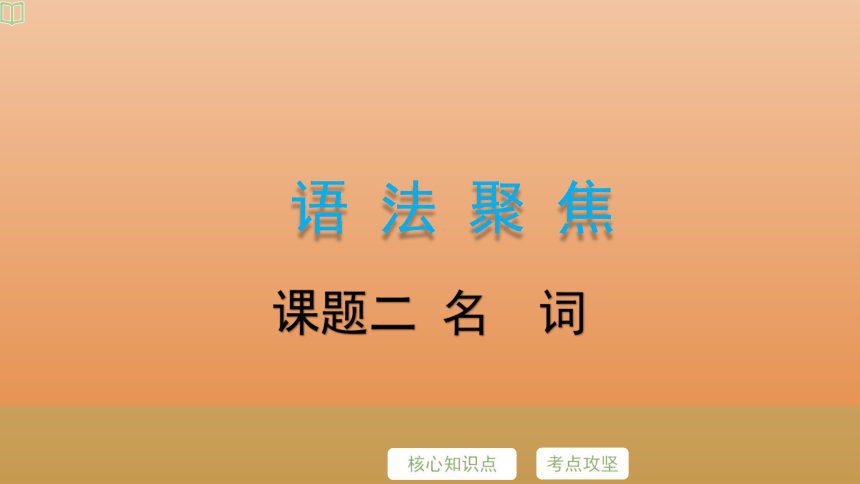
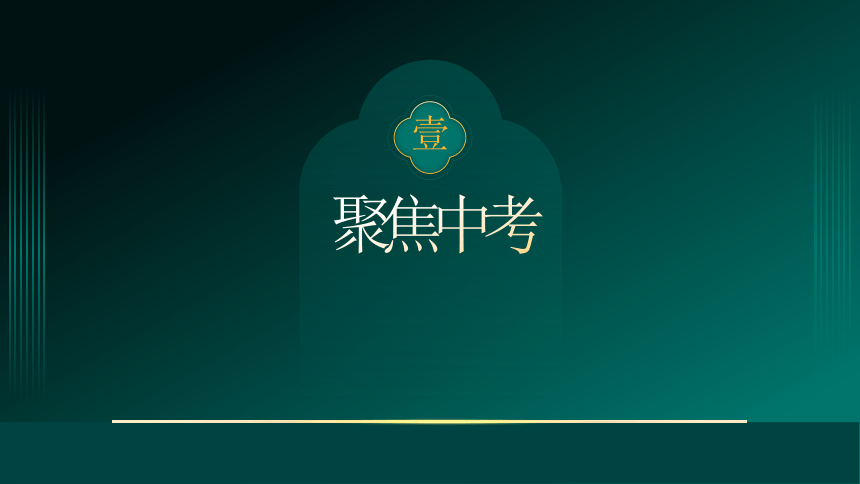
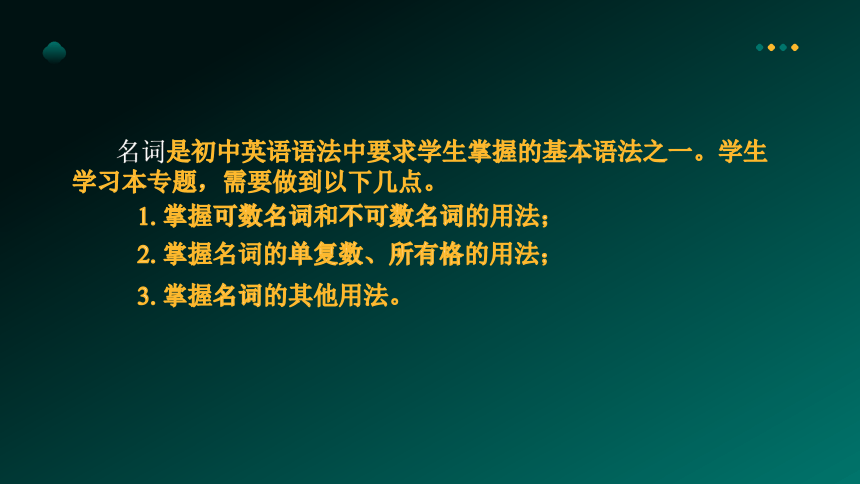
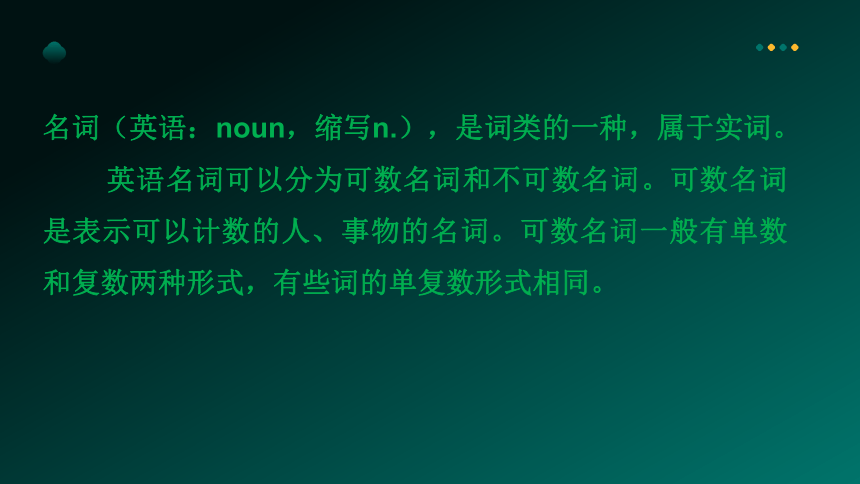
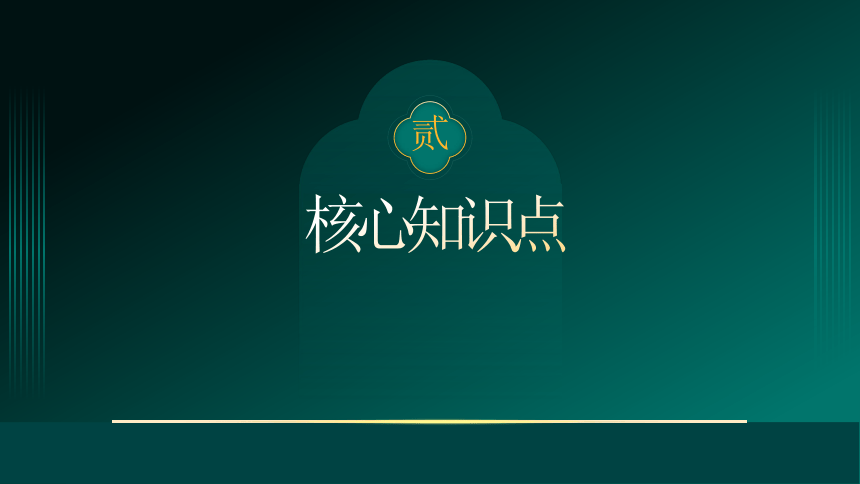
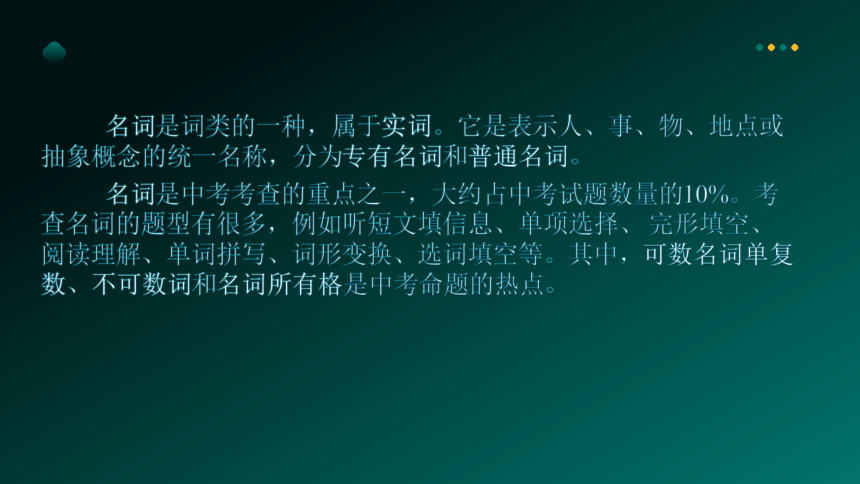
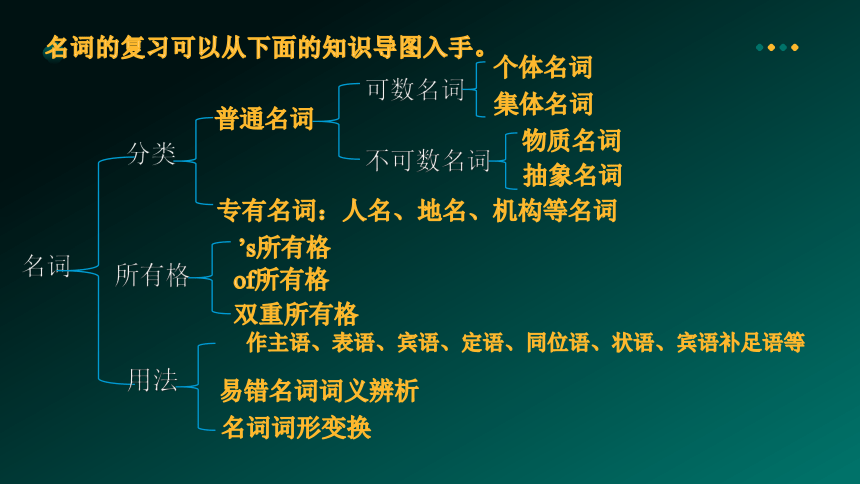

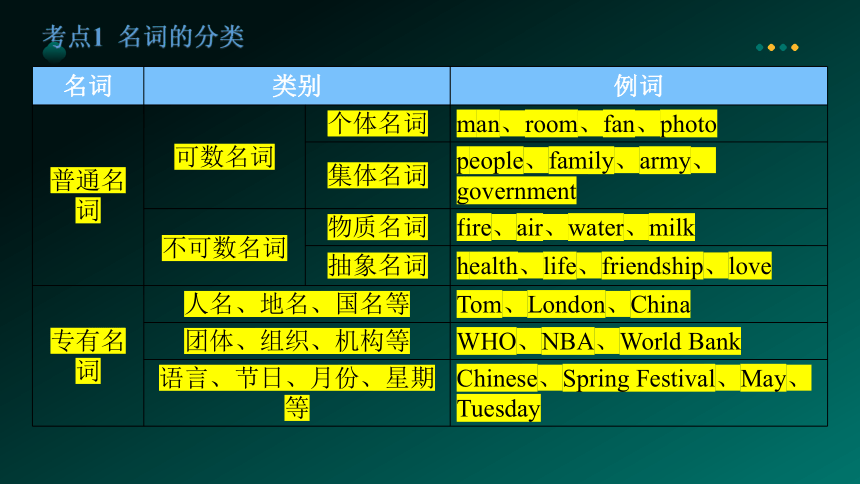


文档简介
(共42张PPT)
2025年英语中考复习
课题二 名 词
语 法 聚 焦
聚焦中考
壹
名词是初中英语语法中要求学生掌握的基本语法之一。学生学习本专题,需要做到以下几点。
1. 掌握可数名词和不可数名词的用法;
2. 掌握名词的单复数、所有格的用法;
3. 掌握名词的其他用法。
名词(英语:noun,缩写n.),是词类的一种,属于实词。
英语名词可以分为可数名词和不可数名词。可数名词是表示可以计数的人、事物的名词。可数名词一般有单数和复数两种形式,有些词的单复数形式相同。
核心知识点
贰
名词是词类的一种,属于实词。它是表示人、事、物、地点或抽象概念的统一名称,分为专有名词和普通名词。
名词是中考考查的重点之一,大约占中考试题数量的10%。考查名词的题型有很多,例如听短文填信息、单项选择、 完形填空、阅读理解、单词拼写、词形变换、选词填空等。其中,可数名词单复数、不可数词和名词所有格是中考命题的热点。
名词的复习可以从下面的知识导图入手。
名词
分类
所有格
作主语、表语、宾语、定语、同位语、状语、宾语补足语等
易错名词词义辨析
名词词形变换
普通名词
专有名词:人名、地名、机构等名词
可数名词
不可数名词
集体名词
个体名词
抽象名词
物质名词
双重所有格
of所有格
’s所有格
用法
考点攻坚
叁
考点1 名词的分类
名词 类别 例词
普通名词 可数名词 个体名词 man、room、fan、photo
集体名词 people、family、army、government
不可数名词 物质名词 fire、air、water、milk
抽象名词 health、life、friendship、love
专有名词 人名、地名、国名等 Tom、London、China
团体、组织、机构等 WHO、NBA、World Bank
语言、节日、月份、星期等 Chinese、Spring Festival、May、Tuesday
考点2 可数名词的单数变复数
分类 情况 构成方式 示例
规则变化 一般情况 加-s book—books
bike—bikes
home—homes
house—houses
German—Germans
Roman—Romans
American—Americans
boy—boys
分类 情况 构成方式 示例
规则变化 以-f 或-fe结尾 把-f 或-fe 变为-ves leaf—leaves
shelf—shelves
wolf—wolves
self—selves
half—halves
thief—thieves
wife—wives
life—lives
knife—knives
考点2 可数名词的单数变复数
分类 情况 构成方式 示例
规则变化 以-s、-x、-ch、-sh结尾 加-es bus—buses
box—boxes
watch—watches
brush—brushes
以辅音字母加-y结尾 先把-y变i 再加-es baby—babies
city—cities
考点2 可数名词的单数变复数
分类 情况 构成方式 示例
规则变化 以辅音加-o结尾 (或者有生命的名词) 加-es hero—heroes
zero—zeroes
tomato—tomatoes
potato—potatoes
以元音加-o或-oo结尾(或者无生命的名词) 加-s zoo—zoos
studio—studios
radio—radios
考点2 可数名词的单数变复数
考点2 可数名词单数变复数
分类 情况 构成方式 示例
不规则变化 —— 单复数同形 sheep—sheep
deer—deer
Chinese—Chinese
Japanese—Japanese
—— 改变名词中的元音字母 man—men
woman—women
foot—feet
tooth—teeth
—— 其他不规则变化形式 mouse—mice
child—children
【注意】
1. 表示“群”的集体名词作主语时,看作复数,例如:people、police、cattle。
2.以man或woman为前缀构成的复合名词在变复数时,前后两个名词都要变成复数形式。例如:
man teacher-men teachers woman doctor-women doctors
3.以两个名词构成的复合名词,一般把后面的名词变为复数形式。例如:
boy student-boy students bus driver-bus drivers
考点3 不可数名词的数
一般情况下,专有名词、物质名词、抽象名词都是不可数名词。不可数名词一般没有复数形式,但是有些不可数名词在表示不同的含义时也会表现出可数性。
(1)不可数名词的数量表达
①不可数名词没有单复数的区别,不能直接用数字表示数量。要表示“一”的概念时,我们可以用“a+表示数量的名词+of+名词”的形式。
例如:a glass of water 一杯水
a cup of tea 一杯茶
a bottle of juice 一瓶果汁
考点3 不可数名词的数
②如果要表达两个或两个以上的概念,体现数量的计量单位,需要用复数形式,不可数名词不变。
例如:two glasses of water 两杯水
five bags of rice 五袋大米
③不可数名词可与some、much、plenty of、a lot of、a great deal of、a little、little等连用,表示数量的多少。
例如:some water 一些水
a lot of money 许多钱
考点3 不可数名词的数
(2)不可数名词的转化
①可转化为可数名词的物质名词
有些物质名词在表达个体或具体的概念时可转化为可数名词。
例如:wind 风—a wind 一阵风
beer 啤酒—a beer 一杯啤酒
rain 雨—a rain 一场雨
coffee 咖啡—a coffee 一杯咖啡
glass 玻璃—a glass 一个玻璃杯
考点3 不可数名词的数
②可转化为可数名词的抽象名词
抽象名词一般是不可数名词,但是表示具体事物时,可用作可数名词,有复数形式,表示“某种人或物”。
例如:success 成功—成功的人或事
surprise惊讶—令人感到惊讶的人或事
beauty美—美人或美丽的事物
danger危险—令人感到危险的人或事。
考点4 名词所有格
1.’s 所有格
(1)’s所有格主要用于表示有生命的人或物的名词之后。’s所有格的变化规则如下表:
情况 构成方式 示例
普通单数名词 在词尾直接加 ’s Tom’s mother 汤姆的妈妈
Mary’s house 玛丽的房子
词尾已有s的复数名词 在词尾加 ’ my parents’ home 我父母的家
teachers’ books 老师们的书
词尾不带s的复数名词 在词尾直接加’s children’s holiday 孩子们的假期
women’s work 妇女们的工作
考点4 名词所有格
(2)’s所有格的特殊用法
①表示两人或多人共有一件东西时,只在最后一个名词后加’s所有格;如果东西为各自所有,则在这几个名词的后面都加’s所有格。
例如:Tom and Mike’s room 汤姆和迈克共有的一个房间(共同拥有)
Tom’s and Mike’s rooms 汤姆的房间和迈克的房间(各自拥有)
②时间、距离、国家、城市等无生命的名词的所有格也可用’s所有格。
例如:today’s newspaper 今天的报纸(时间)
five minutes’ walk 5分钟的步行(距离)
China’s weather 中国的天气(国家)
Nanning’s streets 南宁的街道(城市)
考点4 名词所有格
③’s所有格后的名词如果是店铺、医院、学校、住宅及公共建筑,该名词通常可以省略。
例如:go to my aunt’s (home) 去我阿姨家
at the pet’s (shop) 在宠物店
at the doctor’s (office) 在诊所
④else常用于不定代词、疑问代词或疑问副词后,表示“另外,其他”,其所有格形式为 else’s。
例如:The dictionary is not mine. It’s someone else’s.
这本字典不是我的,是别人的。
考点4 名词所有格
⑤复合名词的所有格,在最后一个词的词尾加’s。
例如:This is my daughter-in-law’s car. 这是我儿媳妇的小轿车。
⑥’s所有格表示的节日如下表:
母亲节 Mother’s Day
父亲节 Father’s Day
儿童节 Children’s Day
妇女节 Women’s Day
愚人节 April Fool’s Day
元旦 New Year’s Day
教师节 Teachers’ Day
考点4 名词所有格
2. of 所有格
“名词+of+名词”构成 of所有格。
(1)表示无生命东西的所有关系。
例如:The windows of the house face the sea.
这个房间的窗户面向大海。
There is a tall tree at the end of the road.
这条路的尽头有一棵高高的树。
(2)表示名词化的词的所有关系。
例如:The life of the poor is the biggest problem in this country.
穷苦人的生活是这个国家最大的问题。
●易错点
(1)用 to表示所有格。
the key to the door 门的钥匙
the answer to the question 问题的答案
the way to school 去学校的路
the bridge to knowledge 知识的桥梁
the exit to the building 建筑物的出口
the entrance to the building 建筑物的入口
(2)对于有生命的名词’s 所有格和 of 所有格可以互换。
the girl’s name / the name of the girl 这个女孩的名字
3. 双重所有格。
(1)双重所有格有两种形式:of+’s所有格和of+名词性物主代词。
例如:a book of my sister’s 我妹妹的一本书
a friend of mine 我的一个朋友
(2)双重所有格中带有’s所有格的名词必须是一个明确限定的指人的名词,同时of前面的名词必须为不确指的名词,常用冠词、数词、不定代词或指示代词等修饰。
例如:some speeches of Mike’s 迈克的一些演说
a cousin of my father’s 我父亲的一个表弟
考点5 名词的用法
句子成分 示例
主语 Spring is my favorite season. 春天是我最喜欢的季节。
表语 They are all heroes. 他们都是英雄。
宾语 May I borrow your dictionary 我可以借用你的字典吗?
定语 We often attend the evening party.
我们经常参加晚上的派对。
同位语 We Chinese are proud of our country.
我们中国人对于我们的国家很骄傲。
状语 The course lasted two hours. 这堂课持续了2个小时。
宾语补足语 They call the cat “Mimi”. 他们叫这只小猫“咪咪”。
考点6 易错名词词义辨析
1. noise、voice 和 sound
(1)noise意为“噪音,噪声”,特指不悦耳的声音。它既可用作可数名词,又可用作不可数名词。
例如:Noise is another kind of pollution. 噪声是另外一种污染。
(2)voice意为“声音”时,多指人发出的声音。
例如:Don’t shout at the top of your voice. 不要敞开喉咙高喊。
(3)sound含义广泛,指一切可以听到的声音,包括有意听到的和无意听到的。
例如:He heard a strange sound from behind.
他听到背后有一个奇怪的声音。
考点6 易错名词词义辨析
2.person、people 和 population
person 表示“某人”时,着重指个人,为可数名词;
people着重指全体,是集体名词;
population意为“人口”,没有复数。
例如:The person is friendly to us. 这个人对我们很友好。
There are four people in my family. 我家中有四口人。
What’s the population of HK 香港的人口是多少
考点6 易错名词词义辨析
3. question 和problem
(1)question含义广泛,常指主观产生,并需要得到回答或解释的问题。question 一般和 ask、answer连用。
(2)problem常指客观存在的,并急需解决的疑难问题、社会问题以及数学上的难题。problem 一般与 do with、deal with、work out 连用。
考点7 名词词形变换
常考的名词变换为形容词的形式
变化规则 例词
n.+-y cloud—cloudy
sun—sunny(需双写n)
fun—funny(需双写n)
luck—lucky
health—healthy
n.+-ful (若名词以y结尾,变y为i加ful) success—successful
care—careful
beauty—beautiful
考点7 名词词形变换
变化规则 例词
n.+-ese, -ish或 -(a)n China—Chinese
Japan—Japanese
England—English
Africa—African
America—American
India—Indian
Australia—Australian
Europe—European
(注意:Canada→Canadian )
考点7 名词词形变换
变化规则 例词
n.+-al(若名词以e结尾,去e加al) nature→natural
nation→national
culture→cultural
n.+-ly friend→friendly
love→lovely
live→lively
特殊变形 pride→proud
靶向突破
肆
●强化训练
( )1. My parents took me to the amusement park on day. There were so many exciting things to do there.
A. Childrens’ B. Children C. Children’s
( )2.—How far is it from Chongqing to Guiyang
—It’s about two ride by high-speed train.
A. hour’s B. hours C. hours’
( )3. — How far is it from your home to your school
—Not very far. It’s about five walk.
A. minute B. Minutes C. minutes’
C
C
C
( )4. —What fruit would you like, Jenny
—Some , please. They are my favorite.
A. milk B. grapes C. juice
( )5. —Can I help you, sir —Yes, please, I’d like .
A. two cup of tea B. two cups of tea C. two cup of teas
( )6.—What was the of the football match last night
—AC Milan won the game.
A. value B. result C. choice
( )7. Uncle Tom keeps many on his farm and lives a happy life there.
A. cats B. dog C. sheep
B
B
B
C
( )8. —Peter often answers the teacher’s in class, doesn’t he
—Yes, he is very active.
A. problems B. questions C. difficulties
( ) 9. —Are you hungry —Yes, please give us .
A. three bread B. three piece of bread C. three pieces of bread
( ) 10. —Whose room is this —It is .
A. Mike’s and John’s B. Mike and John’s C. Mike and John
B
C
B
●靶向训练
( )1. (2022·合肥) —How is the today
—It’s hot. You don’t need to wear the coat.
A. weather B. traffic C. price
( )2. (2022·云南) Jimmy likes reading, so he often goes to the bookstore to buy some .
A. rulers B. bags C. books
( )3. (2023·广州) Bill has got two .
A. sister B. brothers C. student
A
C
B
( )4. (2022·青岛) —I like the in that restaurant near our school.
—Me, too. They have the best cooks in our town.
A. food B. service C. environment
( )5. (2023·南京)—I have a . What should I do?
—You should go to the dentist.
A. toothache B. headache C. stomachache D. fever
( )6. (2021·株洲) —How can I well with my friends Can you give me some —Sure. First, you should respect them.
A. get along; advices B. go along; advice C. get on; advice
( )7. (2024·鹤壁)—How much do you need?
—We need two cups.
A. milk B. egg C. pear D. potato
A
A
C
A
( )8. (2021·重庆)—Mary, how about going to the
—Good idea. We can read lots of books there.
A. cinema B. library C. hospital
( )9. (2022·西宁)My mother is a in Zhongshan Hospital. She has saved many people’s lives.
A. singer B. doctor C. writer
( )10. (2022·崇左)—What’s your favorite sport
—I like .
A. maths B. spring C. tennis D. milk
( )11. (2020·常州)—Would you like something to drink, Judy
—Yes. Some is OK.
A. bread B. ice-cream C. salad D. milk
B
B
C
D
知 识 梳 理
巩 固 训
2025年英语中考复习
课题二 名 词
语 法 聚 焦
聚焦中考
壹
名词是初中英语语法中要求学生掌握的基本语法之一。学生学习本专题,需要做到以下几点。
1. 掌握可数名词和不可数名词的用法;
2. 掌握名词的单复数、所有格的用法;
3. 掌握名词的其他用法。
名词(英语:noun,缩写n.),是词类的一种,属于实词。
英语名词可以分为可数名词和不可数名词。可数名词是表示可以计数的人、事物的名词。可数名词一般有单数和复数两种形式,有些词的单复数形式相同。
核心知识点
贰
名词是词类的一种,属于实词。它是表示人、事、物、地点或抽象概念的统一名称,分为专有名词和普通名词。
名词是中考考查的重点之一,大约占中考试题数量的10%。考查名词的题型有很多,例如听短文填信息、单项选择、 完形填空、阅读理解、单词拼写、词形变换、选词填空等。其中,可数名词单复数、不可数词和名词所有格是中考命题的热点。
名词的复习可以从下面的知识导图入手。
名词
分类
所有格
作主语、表语、宾语、定语、同位语、状语、宾语补足语等
易错名词词义辨析
名词词形变换
普通名词
专有名词:人名、地名、机构等名词
可数名词
不可数名词
集体名词
个体名词
抽象名词
物质名词
双重所有格
of所有格
’s所有格
用法
考点攻坚
叁
考点1 名词的分类
名词 类别 例词
普通名词 可数名词 个体名词 man、room、fan、photo
集体名词 people、family、army、government
不可数名词 物质名词 fire、air、water、milk
抽象名词 health、life、friendship、love
专有名词 人名、地名、国名等 Tom、London、China
团体、组织、机构等 WHO、NBA、World Bank
语言、节日、月份、星期等 Chinese、Spring Festival、May、Tuesday
考点2 可数名词的单数变复数
分类 情况 构成方式 示例
规则变化 一般情况 加-s book—books
bike—bikes
home—homes
house—houses
German—Germans
Roman—Romans
American—Americans
boy—boys
分类 情况 构成方式 示例
规则变化 以-f 或-fe结尾 把-f 或-fe 变为-ves leaf—leaves
shelf—shelves
wolf—wolves
self—selves
half—halves
thief—thieves
wife—wives
life—lives
knife—knives
考点2 可数名词的单数变复数
分类 情况 构成方式 示例
规则变化 以-s、-x、-ch、-sh结尾 加-es bus—buses
box—boxes
watch—watches
brush—brushes
以辅音字母加-y结尾 先把-y变i 再加-es baby—babies
city—cities
考点2 可数名词的单数变复数
分类 情况 构成方式 示例
规则变化 以辅音加-o结尾 (或者有生命的名词) 加-es hero—heroes
zero—zeroes
tomato—tomatoes
potato—potatoes
以元音加-o或-oo结尾(或者无生命的名词) 加-s zoo—zoos
studio—studios
radio—radios
考点2 可数名词的单数变复数
考点2 可数名词单数变复数
分类 情况 构成方式 示例
不规则变化 —— 单复数同形 sheep—sheep
deer—deer
Chinese—Chinese
Japanese—Japanese
—— 改变名词中的元音字母 man—men
woman—women
foot—feet
tooth—teeth
—— 其他不规则变化形式 mouse—mice
child—children
【注意】
1. 表示“群”的集体名词作主语时,看作复数,例如:people、police、cattle。
2.以man或woman为前缀构成的复合名词在变复数时,前后两个名词都要变成复数形式。例如:
man teacher-men teachers woman doctor-women doctors
3.以两个名词构成的复合名词,一般把后面的名词变为复数形式。例如:
boy student-boy students bus driver-bus drivers
考点3 不可数名词的数
一般情况下,专有名词、物质名词、抽象名词都是不可数名词。不可数名词一般没有复数形式,但是有些不可数名词在表示不同的含义时也会表现出可数性。
(1)不可数名词的数量表达
①不可数名词没有单复数的区别,不能直接用数字表示数量。要表示“一”的概念时,我们可以用“a+表示数量的名词+of+名词”的形式。
例如:a glass of water 一杯水
a cup of tea 一杯茶
a bottle of juice 一瓶果汁
考点3 不可数名词的数
②如果要表达两个或两个以上的概念,体现数量的计量单位,需要用复数形式,不可数名词不变。
例如:two glasses of water 两杯水
five bags of rice 五袋大米
③不可数名词可与some、much、plenty of、a lot of、a great deal of、a little、little等连用,表示数量的多少。
例如:some water 一些水
a lot of money 许多钱
考点3 不可数名词的数
(2)不可数名词的转化
①可转化为可数名词的物质名词
有些物质名词在表达个体或具体的概念时可转化为可数名词。
例如:wind 风—a wind 一阵风
beer 啤酒—a beer 一杯啤酒
rain 雨—a rain 一场雨
coffee 咖啡—a coffee 一杯咖啡
glass 玻璃—a glass 一个玻璃杯
考点3 不可数名词的数
②可转化为可数名词的抽象名词
抽象名词一般是不可数名词,但是表示具体事物时,可用作可数名词,有复数形式,表示“某种人或物”。
例如:success 成功—成功的人或事
surprise惊讶—令人感到惊讶的人或事
beauty美—美人或美丽的事物
danger危险—令人感到危险的人或事。
考点4 名词所有格
1.’s 所有格
(1)’s所有格主要用于表示有生命的人或物的名词之后。’s所有格的变化规则如下表:
情况 构成方式 示例
普通单数名词 在词尾直接加 ’s Tom’s mother 汤姆的妈妈
Mary’s house 玛丽的房子
词尾已有s的复数名词 在词尾加 ’ my parents’ home 我父母的家
teachers’ books 老师们的书
词尾不带s的复数名词 在词尾直接加’s children’s holiday 孩子们的假期
women’s work 妇女们的工作
考点4 名词所有格
(2)’s所有格的特殊用法
①表示两人或多人共有一件东西时,只在最后一个名词后加’s所有格;如果东西为各自所有,则在这几个名词的后面都加’s所有格。
例如:Tom and Mike’s room 汤姆和迈克共有的一个房间(共同拥有)
Tom’s and Mike’s rooms 汤姆的房间和迈克的房间(各自拥有)
②时间、距离、国家、城市等无生命的名词的所有格也可用’s所有格。
例如:today’s newspaper 今天的报纸(时间)
five minutes’ walk 5分钟的步行(距离)
China’s weather 中国的天气(国家)
Nanning’s streets 南宁的街道(城市)
考点4 名词所有格
③’s所有格后的名词如果是店铺、医院、学校、住宅及公共建筑,该名词通常可以省略。
例如:go to my aunt’s (home) 去我阿姨家
at the pet’s (shop) 在宠物店
at the doctor’s (office) 在诊所
④else常用于不定代词、疑问代词或疑问副词后,表示“另外,其他”,其所有格形式为 else’s。
例如:The dictionary is not mine. It’s someone else’s.
这本字典不是我的,是别人的。
考点4 名词所有格
⑤复合名词的所有格,在最后一个词的词尾加’s。
例如:This is my daughter-in-law’s car. 这是我儿媳妇的小轿车。
⑥’s所有格表示的节日如下表:
母亲节 Mother’s Day
父亲节 Father’s Day
儿童节 Children’s Day
妇女节 Women’s Day
愚人节 April Fool’s Day
元旦 New Year’s Day
教师节 Teachers’ Day
考点4 名词所有格
2. of 所有格
“名词+of+名词”构成 of所有格。
(1)表示无生命东西的所有关系。
例如:The windows of the house face the sea.
这个房间的窗户面向大海。
There is a tall tree at the end of the road.
这条路的尽头有一棵高高的树。
(2)表示名词化的词的所有关系。
例如:The life of the poor is the biggest problem in this country.
穷苦人的生活是这个国家最大的问题。
●易错点
(1)用 to表示所有格。
the key to the door 门的钥匙
the answer to the question 问题的答案
the way to school 去学校的路
the bridge to knowledge 知识的桥梁
the exit to the building 建筑物的出口
the entrance to the building 建筑物的入口
(2)对于有生命的名词’s 所有格和 of 所有格可以互换。
the girl’s name / the name of the girl 这个女孩的名字
3. 双重所有格。
(1)双重所有格有两种形式:of+’s所有格和of+名词性物主代词。
例如:a book of my sister’s 我妹妹的一本书
a friend of mine 我的一个朋友
(2)双重所有格中带有’s所有格的名词必须是一个明确限定的指人的名词,同时of前面的名词必须为不确指的名词,常用冠词、数词、不定代词或指示代词等修饰。
例如:some speeches of Mike’s 迈克的一些演说
a cousin of my father’s 我父亲的一个表弟
考点5 名词的用法
句子成分 示例
主语 Spring is my favorite season. 春天是我最喜欢的季节。
表语 They are all heroes. 他们都是英雄。
宾语 May I borrow your dictionary 我可以借用你的字典吗?
定语 We often attend the evening party.
我们经常参加晚上的派对。
同位语 We Chinese are proud of our country.
我们中国人对于我们的国家很骄傲。
状语 The course lasted two hours. 这堂课持续了2个小时。
宾语补足语 They call the cat “Mimi”. 他们叫这只小猫“咪咪”。
考点6 易错名词词义辨析
1. noise、voice 和 sound
(1)noise意为“噪音,噪声”,特指不悦耳的声音。它既可用作可数名词,又可用作不可数名词。
例如:Noise is another kind of pollution. 噪声是另外一种污染。
(2)voice意为“声音”时,多指人发出的声音。
例如:Don’t shout at the top of your voice. 不要敞开喉咙高喊。
(3)sound含义广泛,指一切可以听到的声音,包括有意听到的和无意听到的。
例如:He heard a strange sound from behind.
他听到背后有一个奇怪的声音。
考点6 易错名词词义辨析
2.person、people 和 population
person 表示“某人”时,着重指个人,为可数名词;
people着重指全体,是集体名词;
population意为“人口”,没有复数。
例如:The person is friendly to us. 这个人对我们很友好。
There are four people in my family. 我家中有四口人。
What’s the population of HK 香港的人口是多少
考点6 易错名词词义辨析
3. question 和problem
(1)question含义广泛,常指主观产生,并需要得到回答或解释的问题。question 一般和 ask、answer连用。
(2)problem常指客观存在的,并急需解决的疑难问题、社会问题以及数学上的难题。problem 一般与 do with、deal with、work out 连用。
考点7 名词词形变换
常考的名词变换为形容词的形式
变化规则 例词
n.+-y cloud—cloudy
sun—sunny(需双写n)
fun—funny(需双写n)
luck—lucky
health—healthy
n.+-ful (若名词以y结尾,变y为i加ful) success—successful
care—careful
beauty—beautiful
考点7 名词词形变换
变化规则 例词
n.+-ese, -ish或 -(a)n China—Chinese
Japan—Japanese
England—English
Africa—African
America—American
India—Indian
Australia—Australian
Europe—European
(注意:Canada→Canadian )
考点7 名词词形变换
变化规则 例词
n.+-al(若名词以e结尾,去e加al) nature→natural
nation→national
culture→cultural
n.+-ly friend→friendly
love→lovely
live→lively
特殊变形 pride→proud
靶向突破
肆
●强化训练
( )1. My parents took me to the amusement park on day. There were so many exciting things to do there.
A. Childrens’ B. Children C. Children’s
( )2.—How far is it from Chongqing to Guiyang
—It’s about two ride by high-speed train.
A. hour’s B. hours C. hours’
( )3. — How far is it from your home to your school
—Not very far. It’s about five walk.
A. minute B. Minutes C. minutes’
C
C
C
( )4. —What fruit would you like, Jenny
—Some , please. They are my favorite.
A. milk B. grapes C. juice
( )5. —Can I help you, sir —Yes, please, I’d like .
A. two cup of tea B. two cups of tea C. two cup of teas
( )6.—What was the of the football match last night
—AC Milan won the game.
A. value B. result C. choice
( )7. Uncle Tom keeps many on his farm and lives a happy life there.
A. cats B. dog C. sheep
B
B
B
C
( )8. —Peter often answers the teacher’s in class, doesn’t he
—Yes, he is very active.
A. problems B. questions C. difficulties
( ) 9. —Are you hungry —Yes, please give us .
A. three bread B. three piece of bread C. three pieces of bread
( ) 10. —Whose room is this —It is .
A. Mike’s and John’s B. Mike and John’s C. Mike and John
B
C
B
●靶向训练
( )1. (2022·合肥) —How is the today
—It’s hot. You don’t need to wear the coat.
A. weather B. traffic C. price
( )2. (2022·云南) Jimmy likes reading, so he often goes to the bookstore to buy some .
A. rulers B. bags C. books
( )3. (2023·广州) Bill has got two .
A. sister B. brothers C. student
A
C
B
( )4. (2022·青岛) —I like the in that restaurant near our school.
—Me, too. They have the best cooks in our town.
A. food B. service C. environment
( )5. (2023·南京)—I have a . What should I do?
—You should go to the dentist.
A. toothache B. headache C. stomachache D. fever
( )6. (2021·株洲) —How can I well with my friends Can you give me some —Sure. First, you should respect them.
A. get along; advices B. go along; advice C. get on; advice
( )7. (2024·鹤壁)—How much do you need?
—We need two cups.
A. milk B. egg C. pear D. potato
A
A
C
A
( )8. (2021·重庆)—Mary, how about going to the
—Good idea. We can read lots of books there.
A. cinema B. library C. hospital
( )9. (2022·西宁)My mother is a in Zhongshan Hospital. She has saved many people’s lives.
A. singer B. doctor C. writer
( )10. (2022·崇左)—What’s your favorite sport
—I like .
A. maths B. spring C. tennis D. milk
( )11. (2020·常州)—Would you like something to drink, Judy
—Yes. Some is OK.
A. bread B. ice-cream C. salad D. milk
B
B
C
D
知 识 梳 理
巩 固 训
同课章节目录
- 词法
- 名词
- 动词和动词短语
- 动词语态
- 动词时态
- 助动词和情态动词
- 非谓语动词
- 冠词
- 代词
- 数词和量词
- 形容词副词及其比较等级
- 介词和介词短语
- 连词和感叹词
- 构词法
- 相似、相近词比较
- 句法
- 陈述句
- 一般疑问句和否定疑问句
- 特殊疑问句及选择疑问句
- 反意疑问句
- 存在句(There be句型)
- 宾语从句
- 定语从句
- 状语从句
- 主谓一致问题
- 简单句
- 并列句
- 复合句
- 主谓一致
- 主、表语从句
- 名词性从句
- 直接引语和间接引语
- 虚拟语气
- 感叹句
- 强调句
- 倒装句
- 祈使句
- 句子的成分
- 句子的分类
- 题型专区
- 单项选择部分
- 易错题
- 完形填空
- 阅读理解
- 词汇练习
- 听说训练
- 句型转换
- 补全对话
- 短文改错
- 翻译
- 书面表达
- 任务型阅读
- 语法填空
- 其他资料
